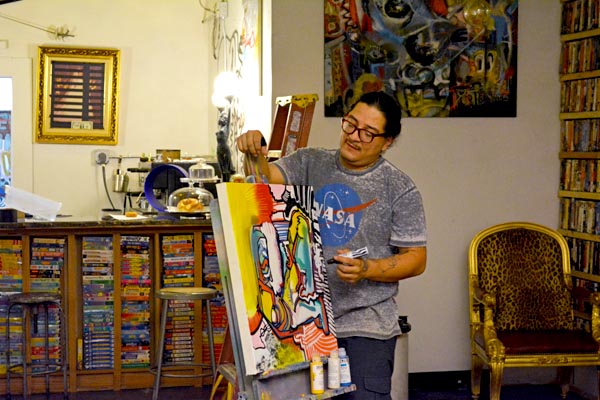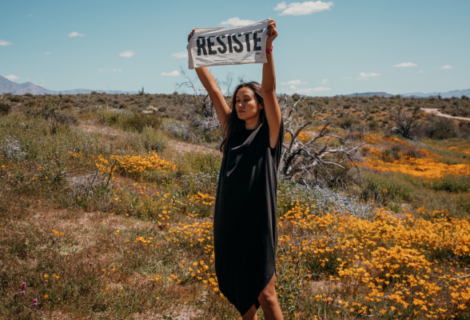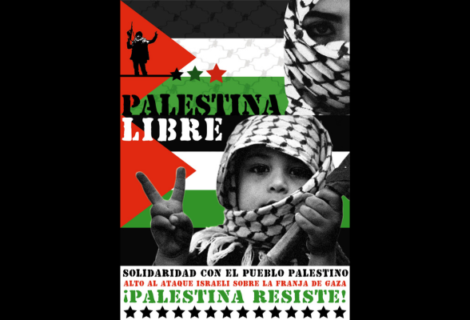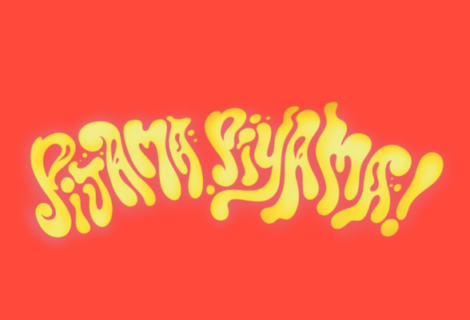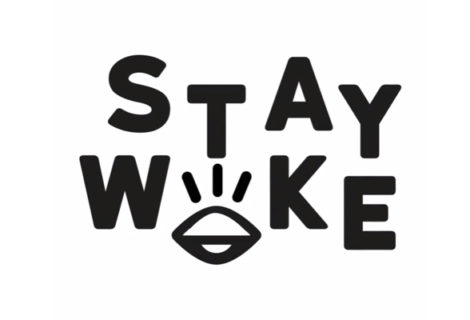Bobby Castañeda on The Greatest Painter Alive
The first time I saw his art was on a pair of lime green pumps a girl I liked was rocking. I heard his name and how he was one of La Phoenikera’s wildest artists. Later I saw his work at local galleries and speakeasies. I ended up hooking up with the girl with the bad-ass shoes. She had one of his paintings in her apartment, and we later hung it at our house when we moved in together.
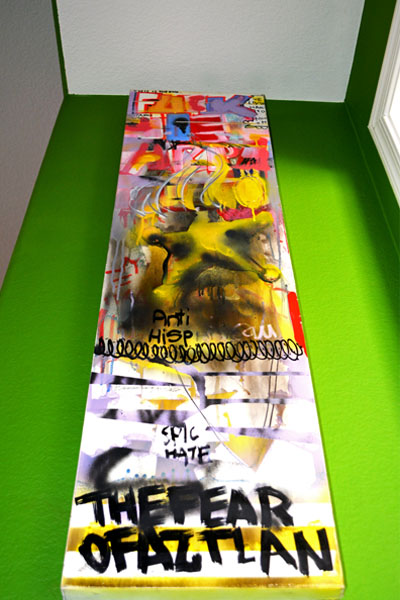
Bobby hangs at our house now. Photo: La Phoenikera.
I never had a sit-down talk with him. I would see him at parties, after-hour shenanigans, galleries, bars, and all kinds of clandestine joints. Like night riders, we would nod at each other, shake hands, and go about our lives.
Thanks to algorithms, his stuff started showing up more in my feed. I’m stingy with my likes, and though his rants and comment threads were hilarious and like-worthy, I would scroll down. Those social media interactions are still tricky for me. Are we supposed to like all the shit people in our feed post, and if we don’t, should we be preoccupied with hurting sensibilities?
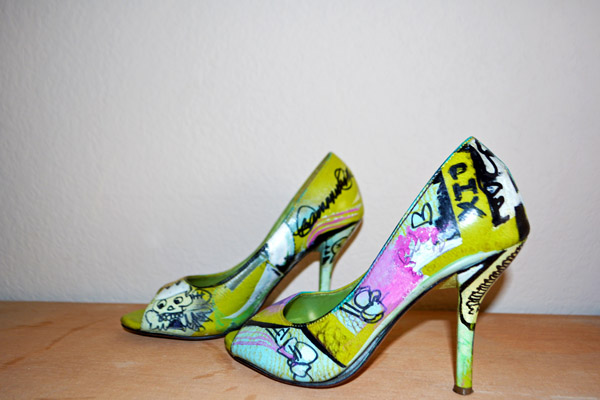
Those pumps tho! Photo: La Phoenikera
I wanted to talk to Bobby Castañeda for a few reasons, mostly because I had a friend crush, and sometimes it’s kinda hard to go up to a dude and say, “Hey, wanna be friends?”
In April I wanted to write a piece about Día de Los Niños (Children’s Day), talk with local artists about their first experiences with art, and the role it played in their earlier years. I contacted a few, but only Bobby responded.
A few days later, and almost a decade after seeing his art on a pair of sassy shoes, we sipped some of his devilish cold brews at his studio/gallery/VHS kingdom.
It was the first of many visits to Castañeda Studios this year, and our chats were all over the place: childhood, the Santo Niño de Atocha, sell-out artists, movies, politics, the golden hour (not showering you filthy minds), culture vultures, what needs to happen in La Phoenikera’s culture scene, and why he is the greatest painter alive.
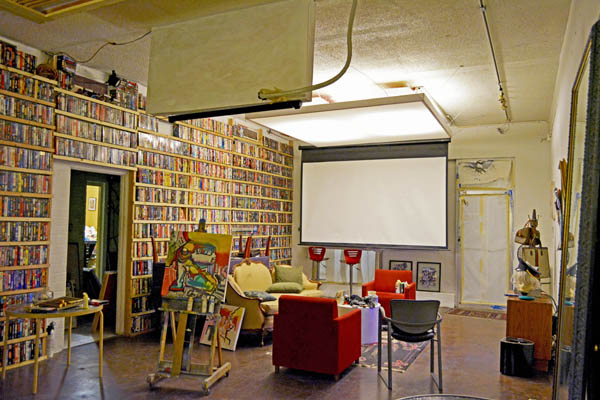
Castañeda Studios/VHS Kingdom. Photo: La Phoenikera.
Bobby on nurturing the inner child
I have a ridiculous media collection; it’s beyond that word. So I go over that, music, movies, books, I always dig deep for my new paintings. You gotta dive in there and pull out whatever you can to nurture the inner child. But that’s the thing, you cannot only have references, there must be emotion. You can paint about references all day, but if there’s no emotion, then it’s just robotic. As an artist you must show beyond what’s apparent, you need to make people feel.
The inner child is found in passion, in being in the moment, waking up and wanting to do things, which keeps the child up. It’s like the golden hour, that’s when my inner child comes out, that’s when I can create. He’s up and about, or she, I don’t know, maybe an “it.” I mean, it’s my soul, so I don’t know, it doesn’t have a gender, right? I think it’s just energy. So that creative energy, that golden child is awake at 4:00 a.m.
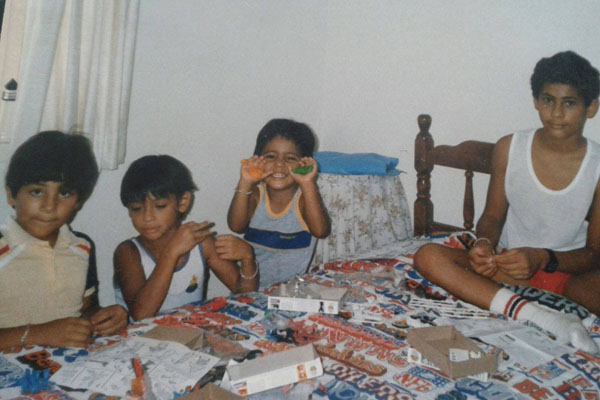
Bobby far left, assembling toys with his siblings circa ’87 or ’88. Photo: José Luís Muñoz.
How does the golden hour work for you?
I mostly work at the studio, and I break my day into blocks: work for 4 hours and take 4-hour naps. It’s weird because sometimes I drink too much coffee and can’t sleep.
What’s up with your love affair with coffee?
Before I met Ali [former coffee shop partner], I never drank coffee, I thought it made me wild, and now I know which ones are shitty. I know if the roasting wasn’t done at the right temperature or the bean was not grown at a proper altitude, stupid shit like that.
Aside from art, how does your inner child manifest?
The other day a friend died, he was a dude from the streets, and I thought about how fucked up it must be to die and not have done the things you wanted to. So not too long ago, in the middle of the night, I asked myself, ‘What do you want to do, Bobby?’ And I said, ‘I want to go to Oakland.’ I drove 13 hours, got there, checked out some galleries, went to SF, smoked some weed, got Chinese, met with some ladies and ended up having a cool night; the next day I was driving back. If you don’t do those things, you don’t allow that energy, that life force to come out. It goes back to that inner child, kids tell you what they want to do at the moment, there is no tomorrow for them. One has to listen to that voice; I’ve been doing that lately.
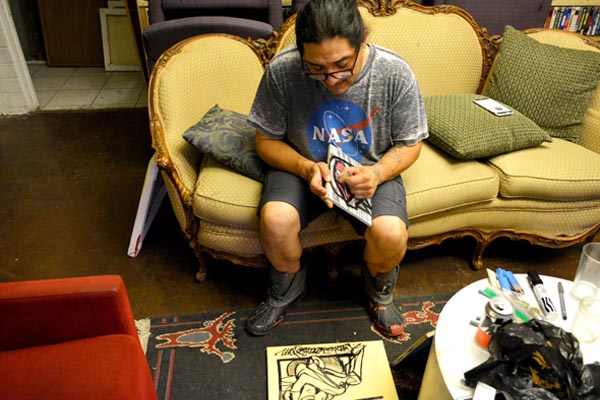
Bobby at his golden hour. This was around 3:40 a.m. Photo: La Phoenikera.
Do you feel you have to say what you feel now?
I’ve always been good at doing whatever I want and saying whatever I want. I do this because if you repress shit like that, you start building boxes around that inner life force.
How old are you?
I turn 40 in November, and I don’t feel it. I’m like, whatever, I’m gonna be at it ’till I’m 80. I’ll still be creating art, keeping tapping into that energy that never goes away. It keeps surfacing, knocking at the door, and I’ll keep opening it.
On his first experience with art
When I was a kid, there was no museum in Rio Grande, Zacatecas. The only exposure to art was through the church, which was in front of my grandma’s house. That’s where I first saw paintings, sculptures, and glass work. To me, it was like we were going to these caves where they had old-school knowledge. I thought it was very dark and sometimes weird.
I remember once we went to “Plateritos” when I was young, and I was like, ‘holy shit! This is like a horror show with all the maimed people and shit’. It’s where the Santo Niño de Atocha is and it’s a big pilgrimage, so if somebody gets injured o están bien chuecos, el niño los arregla, the saint hooks them up, and they get better.
The walls of the church where El Santo Niño de Atocha hangs out are filled with testimonies of people who’ve been helped by him, and some put pictures or drawings of themselves or their loved ones, so that was an amazing experience when I was a kid. Some people went balls out with it and created incredible pieces of art.
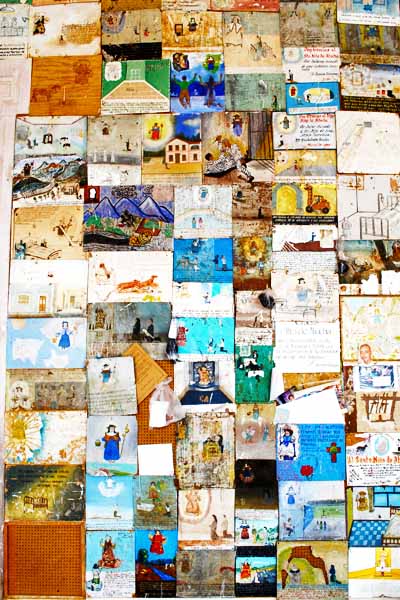
Wall of art thanking the Santo Niño de Atocha…these peeps aren’t joking around with their devotion.
Where did you grow up?
I was born in Chicago, raised in Zacatecas, spent some years in Oklahoma, and spent my adolescence in Phoenix. When I was tiny, I was sent back to Mexico to live with my grandmother. I couldn’t build that strong of a connection with my mom because she was working in Chicago, so I became very attached to my grandmother. Soy Mexicano, and I appreciate my mom for sending me to live there because I know where I come from and what it took for her to get here.
When did you start creating?
I love colors and patterns because of my grandma, who was a seamstress. She would cut fabric, and I would play with the leftovers on the ground and create shapes and stuff. That’s why I hung out under the sewing machine when she was working. That’s when I discovered I could materialize my ideas and saw people doing that on paper. From then on, I would ask for pens and paper.
I must have been 4 or 5 years old because that’s when they moved me to Oklahoma. I moved a lot, but most of my adolescence was here in Phoenix, and there was a bunch of hooliganism going on, and we would go out and tag shit around 4 a.m. It was me and a homie just vibing, murdering the city.
I make art the best way I can, like the people who drew their testimonies for el Santo Niño de Atocha, that’s how it comes out.
Can artists be proud of their culture and represent it without exploiting it?
That’s when the self comes into play because you’re a mixture of cultures, in a sense. Some people like to define themselves first with something like Mexican painter, Guatemalan, or any other thing that they feel should supersede painter, sculptor, or creator.
You’re not a Guatemalan dancer, you’re a dancer and you should strive to be the best you can be, that’s how you represent where you’re at, where you’re from, where you’re going. I think that’s what’s more important than if you’re painting Indigenous themes or if you have a love for Día de Los Muertos and painting the shit outta that, it’s not even about that, because when people look at a painting, man, in my opinion, your audience wants you to tell them a story, they want to know the artist through that, without even have to talk to them. I feel that’s the best way to represent your culture; why limit it to denominations?
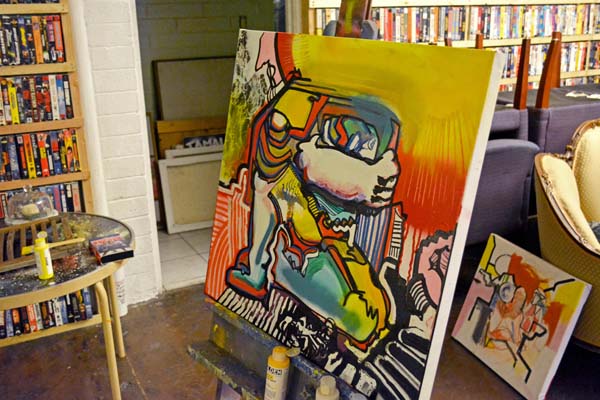
Bobby loves to flip his canvases around, not too much though, ’cause the “juju” might slip off. Photo: La Phoenikera.
On Phoenix as a city
One of the beauties of Phoenix is the meaning behind its name: rebirth. This place is one where people can reinvent themselves and start over, a place where you can figure yourself out and what your skills are. This city has grown a lot, and created an environment that allows you to do that. How I look at it is that training is over, you’ve had time to find yourself, and it’s time to work; now it’s time to put into the culture what you’ve been drawing. It’s ok to put your name out there and have shows and paint murals, but what are you doing for the community? How are you helping the new artists find themselves? Those high school students are looking up to someone on how they are supposed to develop.
On what needs to happen in La Phoenikera
We need to stop importing culture, which is what’s happening. We need to realize what’s here, and this is in regard to the public art sector, where grant dollars are going within the community. We need to start funding artists in Arizona, in Phoenix, and not out-of-state artists. And yeah, some of the local artists are putting up shitty proposals. Their ideas might be a little wack and whatever, but I feel like the purpose is to make all these institutions like The Arizona Commission on the Arts, ASU, the City of Phoenix, understand the importance of this.
And I’m not talking about Indigenous art—we have The Heard for that. I’m talking about Phoenician art, art that has roots in the city but is not culture vulture-ish.
We also need to nurture Arizona art starting at schools and fund art programs in schools. That’s why people are so depressed and shit, because they don’t have art in their life.
On who or what is a culture vulture
The person who paints or reinforces stereotypes, the ones who use culture as a token, if you’re doing that, you’re not growing or nurturing the culture; you’re just profiting from it, picking the fruit right off and then saying, ‘I did this.’
VHS Tapes
We have thousands of VHS tapes all over the place—it’s ridiculous; we have rooms full of them. We want to eventually have a swap meet of tapes, geek out. We even have a collection of Jalisco Cinema—I think that’s what it’s called—which is basically a bunch of movie corridos. We seriously have a ridiculous collection—there’s so much tape, even in the bathroom.
People started donating them to us, and we said okay. But we had to stop accepting; it got crazy.
One of my favorite things to do when someone comes in is to ask what their favorite movie is or was and then look for it. Most likely, if you tell me the movie, I know if we have it or not. Ask me a movie you liked when you were a kid, and I’ll find it.
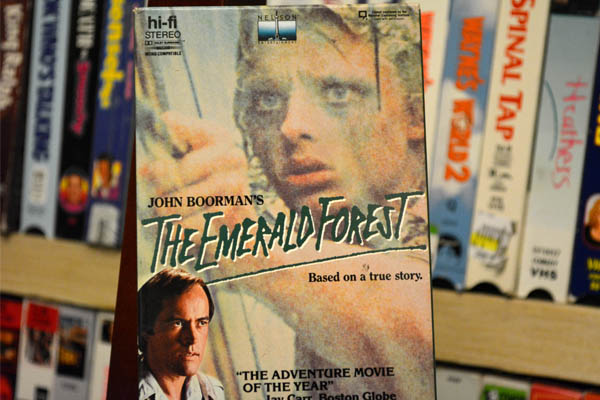
His collection ascends to more than 4k tapes! Photo: La Phoenikera.
Where do you eat? Any good places around?
There’s this clandestine place not too far from here, where they serve awesome food. It’s a mom-and-pop place without a license, and their Menudo is delicious. It’s just a lady, her husband, and their daughter. They serve breakfast on the weekends, too. I won’t give their location because I don’t want to get them in trouble. People can ask me, though, and I’ll tell them.
What type of art do you create?
What I create draws you into a story, lets you go for a second, and lets you absorb the next one. I want the spectator to say, ‘I saw three paintings of yours, and they’re all different.’ I want them to question what I’m about. Maybe you want to read the words on the paintings, maybe look at them from a different angle.
That’s when it’s real when it’s right in front of you, and it moves you, that’s it. And people will say, “Well, that’s subjective.” No, it’s not, you either know and you see and differentiate the good from the shitty. Yeah, there’s different schools of thought but you’re disconnecting by saying that, you say that’s not for me and you haven’t even looked at it. Many people say to me “you do the same thing, you didn’t even look at it.” But no, some of the stuff is formulaic, so much so that you can tell, and that’s what’s not subjective anymore.
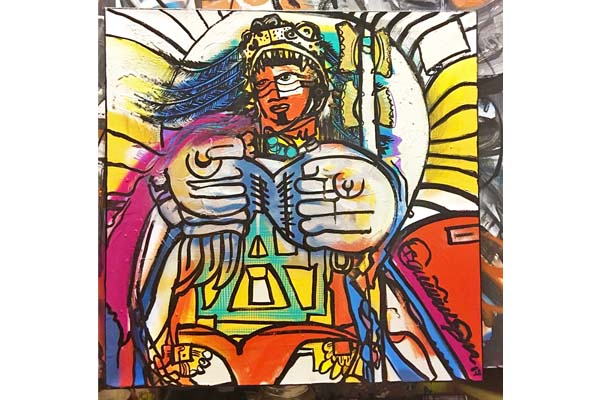
“aztecawarriorprincess” by #greatestpainteralive. Photo: Bobby Castañeda.
Is art subjective?
Some might say it is, but people know, they can tell when the artist has to try a little harder. So, going back to that energy, with my work, I want people to feel it radiating, to see my inner child in that painting.
That’s why I kinda throw iconic images sometimes, so that people can find their own references to that and create a dialogue with the art in front of them. I want to do a series with Capulina and all the Mexican Pulp Cinema. I also have been thinking of doing my take on los hermanos Almada and Lola la Trailera; I believe it connects with people and that’s my shit, that’s what I do.
Are you about Bobbyfying La Phoenikera, or against stamping it with your art?
Here’s the thing: you have to pick and choose those things. Say someone says to me that they’re going to put my art on everything, skateboards, cups, apparel, throw my shit onto comforters, all my shit in stores all over the nation, and you know those opportunities present themselves to all working artists and most won’t deny those opportunities.
In a sense, I wouldn’t take an offer like that because It would mean that I have to take everything I’ve ever said and eat it. I would be eating my own shit at that point, and that’s not for me because I have a grandmother who raised me, I got a mom that’s looking up to me even though she doesn’t understand what I’m doing, I have daughters who are looking up and seeing what I’m doing, they don’t want to see me sell myself short.
This is my life, man, it’s real, that’s why I say to people who are hobbying or have formal training to do it, they don’t understand how much life force I’ve had to put just to bring this stuff out, you know? It’s a struggle, it’s a heavy thing because I want to express, I want to shout and scream, but I know that shouts and screams don’t sell for shit, and then I’m like, ‘Where do I compromise?’ And that’s something that every artist needs to figure out. Where does Bobby start selling himself, and how much is he selling himself for? So, what I do is create. Sometimes my grandma would say “pinta algo bonito, me gusta lo que haces pero pinta unas flores, una virgen.” So every time I hear that I try to do something, I paint a virgen or the evolution of it, which is to be a representation of all women, not as a religious doctrine or a set of rules. It’s this unconditional love, it’s not a man on a cross, it’s mother and its many manifestations, you know, it’s Eva, it’s the whole thing together.
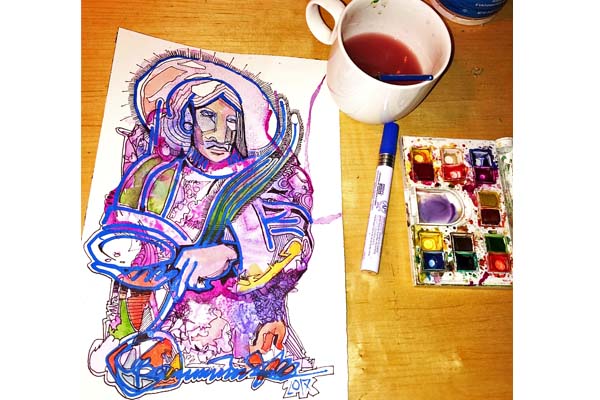
Watercolor by #greatestpainteralive. Photo: Bobby Castañeda.
On the Latino Cultural Center
First of all the name of it, the name says a lot, culture is where you throw all the arts together, dance, painting, music, sculpture, etc. the things that make us unique. They want to label it the Latino Cultural Center like a license plate, like saying “this is what it is people, right here, this beautiful building of Latino culture”…that’s bullshit, let it stand on its own.
The Taj Majal doesn’t need to be explained or labeled or the Guggenheim, the same thing with the Louvre. They’re buildings that house culture, and that’s what needs to happen. We need to think about it correctly from the get-go, then we can go and talk about what’s going to be inside it, because right now what we’re gonna get is a cookie cutter type structure that looks modern instead of us looking for a local young architect that has some wild ideas, something that has a connection with the place and the earth.
They also have to think about what was there before. We had indigenous people that built all sorts of stuff, that’s the kind of the reflection that needs to happen. We’re in the middle of Aztlán, that needs to be represented. There should be a leaning towards Olmecs, Zapotecs, Aztecs, Yakis, Hopi, and all indigenous communities. It should have that root structure, but at the same time, it needs to be contemporary. So that people from Spain or any other part of the world would visit it.
The building itself should be a work of art representing our city’s culture. Let’s be real: The biggest representation of all Latinxs here is Mexican. It’s an old culture. We can’t just say that we all have old cultures; this is one of the first cultures that settled here.
Isn’t that nativism, in a sense?
It is, but you gotta roll with the punches, that’s a river, let’s cross this river, let’s not go up the fucking river, against the current, no one is going to get to the other side like that, you’re gonna lose too much energy. Cross the river with the current. Let them label it, let them do that; it’s more about how we feel about it. If we can’t do that, we’re not failing you, me or any other artist, we’re failing three or more generations that could have had the chance to be exposed and develop a consciousness, to figure out where their roots are. Culture is food for the soul; we just have different flavors, and they’re all out there. It could be big if it’s done well in a forward-thinking way. It should be like a compound of buildings with strong educational programs, Oaxacan wood carving, basket weaving, fiber arts, its evolution, and the inclusion of technology. We must show where we were, where we are, and where we’re going.
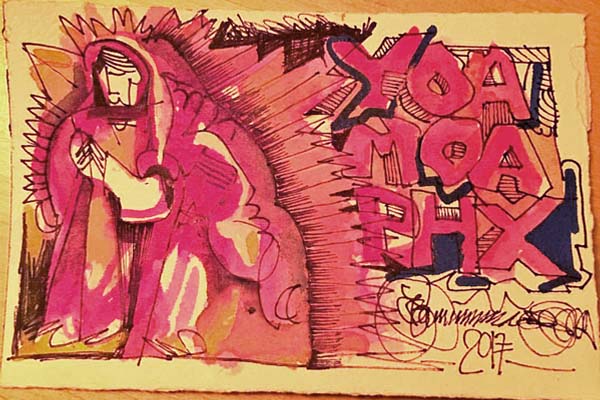
“Yo amo a PHX” by #greatestpainteralive. Photo: Bobby Castañeda.
Greatest painter alive?
See? You heard someone associate that with me. It is mostly a conversation starter. I did that in New York; I would say ‘hi, I’m the greatest painter alive,’ and people would be like, “look at this guy, his humility, oh my God!” and other people would ask how I could claim that and they’d mention Basquiat, Picasso, or others, and I’m like, ‘those fools are dead, some of them for centuries, I’m doing this now and in my universe I’m the best at what I do.’ I know I can paint a masterpiece tomorrow, but I’m programming myself to do that because society said I was not good enough or I didn’t have this or that. In my mind, in my reality, I am the greatest, and no one can refute that.
Did you ever formally train in the arts?
I had a scholarship for the Savannah School of Arts, but right before I left, my girlfriend told me she was pregnant, so….
Who is this “Shifty” character I have been hearing about?
It’s a character who essentially is me in a sense. He says things I can’t, like sometimes I have little speech bubbles and say little comical things. One of my girlfriends named him. She said that it needed a name and then said Shifty because of his eyes.
There’s a song by The Rolling Stones, Sympathy for The Devil, and it says, “Just as every cop is a criminal and all the sinners saints,” so that kinda inspired it. It started as a calaca with wings, a halo, and a scar on its wing because I have a scar there. Originally, I had it like that because I wanted the kind of negativity that you associate with skulls, but it’s also a good thing; then there’s the wings that represent a saint, and then I switched the halo for a crown to represent art.
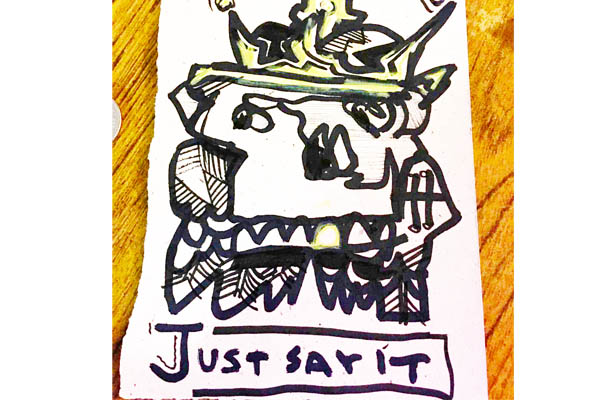
Shifty! Photo: Bobby Castañeda.
What’s the end game?
I’m excited about what I’m going to do next. Who’s gonna look at it? I Really don’t give two shits at this point, I’m thinking 20 years from now, right now I’m just fucking around, who knows what I’ll be doing then.

